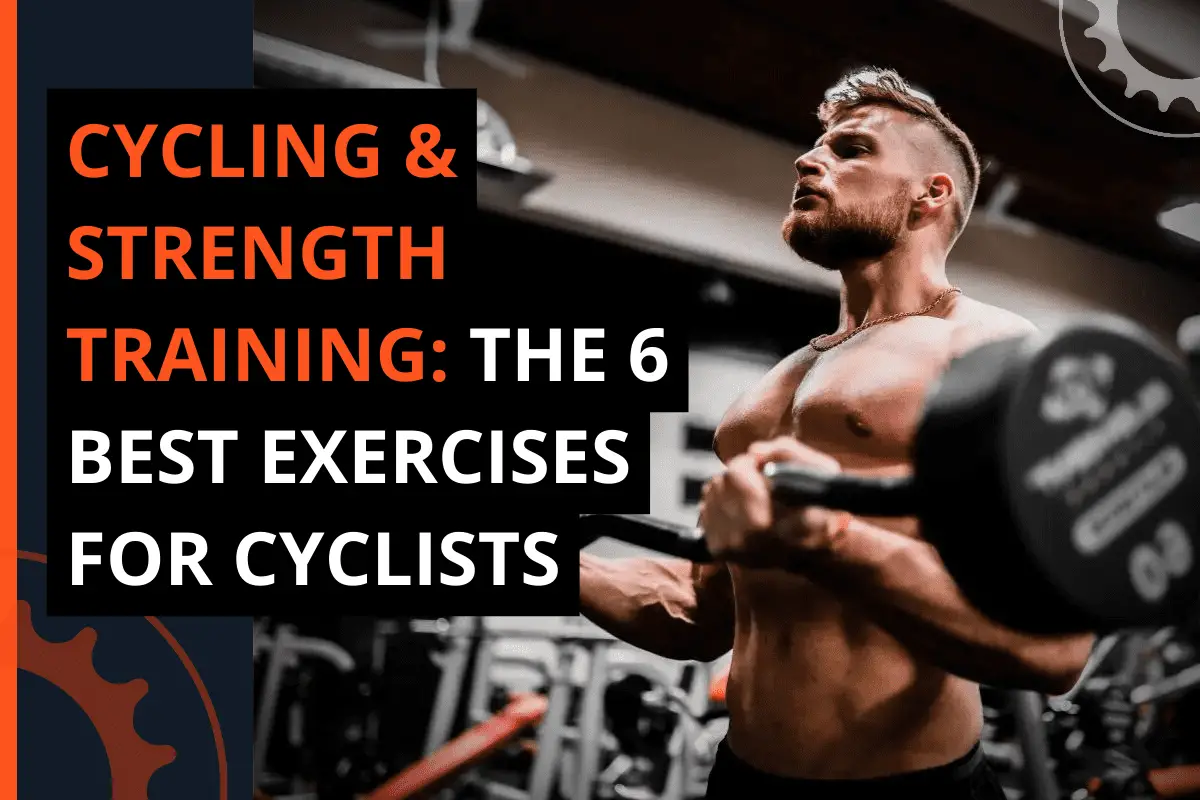Strength training is important; it can easily fit into our cycling routines and drastically increase our ability as cyclists. But what are the best exercises for cyclists?
In this article, you will learn the benefits of strength training for cyclists, how often a cyclist should do strength training, and the best strength exercises for cyclists so they can ride longer, faster, and stronger than ever.
Lunges, leg lifts, burpees, kettlebell swings, planks, and front squats are some of the best exercises for bikers. Talk to a personal trainer or cycling coach about the best exercises for you.
Editor’s note: This article was updated on July 7, 2022, to include additional information about the best strength exercises for cyclists.
Before learning about the best strength exercises for cyclists, let’s first understand the benefits of strength training.
The benefits of strength training for cyclists
Whether you are a total beginner or an elite athlete, strength training can help you become faster and more resilient on the bike. Weakness is usually linked to low bone density and muscle atrophy, so strong riders are less likely to get hurt in a crash or from using their bikes too much.

Stronger cyclists are also more efficient at power transfer and muscle recruitment throughout the pedal stroke. The primary purpose of strength training for cyclists is to improve riding performance. Leg and posterior chain exercises help transfer power, which is especially important when sprinting and climbing. Upper body training helps with control and staying in a good riding position, and core workouts improve these skills.
Additionally, strength training makes you a healthier, fitter, and more versatile athlete and person, a benefit that lasts long after race day.

State Bicycle Co. Black Label 6061

State Bicycle Co. Black Label 6061
How often should a cyclist do strength training?
Regardless of the season, you should strength train at least twice weekly. However, you are less active during the offseason (around September or October), so to combat muscle loss, strength train two to three times per week. Just remember to go slowly and give your body time to acclimatize to this new type of stress.
The six best strength exercises for cyclists
Simple strength workouts can be an excellent complement to any training regimen. The six workouts listed below are the most effective ways to build strength for use on the bike. They require little to no equipment, and some may be completed at home with minimal or no equipment. Investing in your shoulders, core, and legs will allow you to ride longer and stronger all year.
1. Lunges with weight
Lunges are great for cycling since they work one leg at a time, targeting your quadriceps, hips, and hamstrings. To practice correct form, it is strongly encouraged to begin without weight. Two typical lunge faults are allowing the knee to extend beyond the leading foot, bending the body forward, and jerking it back during the forward and backward movement phases. Focus on higher rep ranges of 15–30 reps per set, with 3-5 sets as a goal. Add weights for best results.

2. Leg extensions
Leg extensions work wonders. Working one leg at a time builds balanced strength (most of us have a stronger side), allowing you to avoid muscular imbalances that can lead to injury. This technique also works your outer glutes, which helps you stay steady in the saddle and reduces side-to-side shaking, which can cause back and knee problems.
3. Burpee
Burpees are an excellent full-body exercise. The movement incorporates all major joints and is designed to be performed explosively. Pushups and a standing jump at the conclusion can be added as variations. Complete 3-5 sets of rapid repetitions in the 10-20 rep range.
4. Kettlebell swings
Kettlebell swings are one of the best workouts. Proper technique is essential, so begin with a lighter weight and work your way up. Maintain a strong core, a straight back, and thrust from your hips and lower body, propelling your arms and weight forward.

Kettlebell swings work the quads, hamstrings, and hips. Swing the kettlebell with an energetic movement and grip it strongly! Begin with 15–25 reps, 1-2 minutes of rest between sets, and 3-5 sets as a goal. When your form becomes sloppy, stop the set. When completing any dumbbell or kettlebell strength exercises, keep your body posture in mind so that it does not negatively impact your health.
If you don’t own a kettlebell, here are some options.
[azonpress template=”grid” asin=”B0731DFTR2,B0093CMYT6,B07X64MXBS”]
5. Planks
Planks are one of the most basic exercises, but they are also one of the most effective for improving core strength. Planks may be laid anywhere and utilized all year. Planks work your shoulders, stomach, and lower back. Lifting one leg makes each set difficult and targets the lower back even more. Start with 30–60 second holds per round and work your way up to 60–90 seconds.
6. Front Squats
Squats should be a regular part of your training routine. Front squats strengthen the hips, quadriceps, and hamstrings and are ideal for use throughout your workout’s max strength and muscle endurance.
Always begin with a modest weight and build a base of higher reps (15–30) before integrating a heavyweight, and always employ a spotter to check form and aid in safety while lifting heavier loads. Squats are useful for cyclists because they help balance the hamstrings by working them differently than the pedaling action.
You should squat low enough so your thighs are about parallel with the ground—an angle your legs will become accustomed to through pedaling. In addition, squats target the quadriceps and glutes.
If you want even more tips, watch the video “5 Core Exercises For Cyclists – Improve Your Strength On The Bike” from the Global Cycling Network YouTube Channel.
Frequently asked questions (FAQ)
Do you still have questions? Here are some of the most common questions about the best ways for cyclists to build strength.
Is strength training good for cyclists?
While some argue that strength training is unnecessary for cyclists, it can be a valuable component of a cycling training program. Cycling necessitates leg strength.
Are deadlifts good for cyclists?
The deadlift is another basic workout that everyone should undertake throughout the off-season. Because each leg must hold the load separately, the single-leg variant of this exercise is ideal for cycling because it focuses on the hips and hamstrings and helps address muscular imbalances.
Is core strength important for cycling?
Contrary to popular belief, the upper body is crucial to total cycling performance. Your upper body works in unison with your legs to propel you forward, particularly your core.
Additionally, planks help cyclists grow stronger and more fatigue-resistant on the bike. They are a terrific tool to develop and maintain the core and upper-trunk strength essential to riding a bike well.
Conclusion
Strength training can help you improve as a cyclist and a healthy human, regardless of your goals or degree of experience. It’s one of the most crucial yet often underestimated parts of an athlete’s training, with benefits ranging from increased speed and efficiency on the bike to increased bone density and physical resilience.
You’ll be able to enhance your cycling strength and conditioning in no time if you stick to the exercises and schedule we’ve outlined! You’ll also protect your knees and other joints from harm. So, what are you holding out for? Give these workouts a shot and see what happens!
This article covered the benefits of strength training for cyclists. How often should a cyclist do strength training? And the best strength exercises for cyclists. Here are some key takeaways:
Key takeaways
- Whether you are a total beginner or an elite athlete, strength training can help you become faster and more resilient on the bike.
- Because weakness typically correlates with inadequate bone density and muscular atrophy, strong riders are more resistant to injuries in the event of a crash or repetitive use.
- Stronger cyclists are also more efficient at power transfer and muscle recruitment throughout the pedal stroke.
- Strength training two to three times per week is sufficient for most riders during the offseason.
- Investing in your shoulders, core, and legs will allow you to ride longer and stronger all year.
So, are you a gym nut who loves to work out, or do you dread it? Did we cover everything you wanted to know? Let us know in the comments section below (we read and reply to every comment). If you found this article helpful, check out our full blog for more tips and tricks on fixed-gear and single-speed cycling. Thanks for reading, and stay fixed.
Helpful resources
- Strength Training for Cyclists: 10 Exercises for Cycling Weight Training – TrainerRoad Blog
- Articles about Fixed Gear and single-speed Cycling and Equipment
- Fixed-gear bicycle – Wikipedia
















